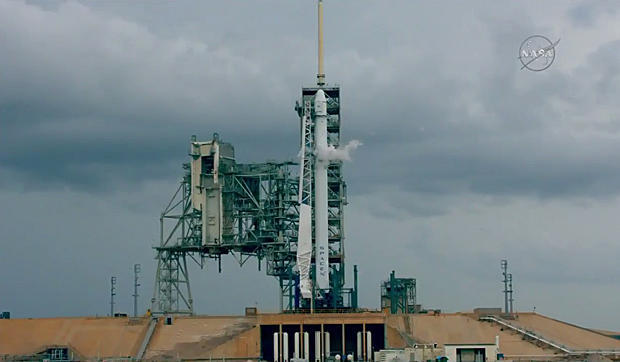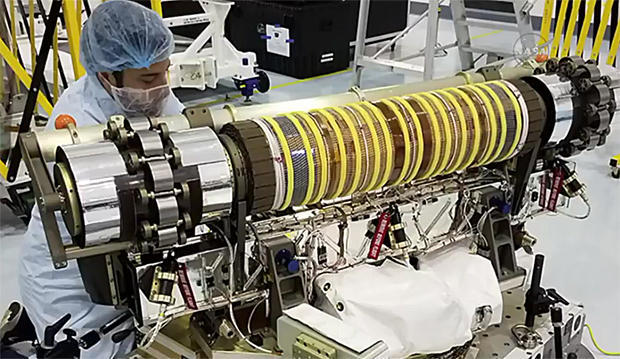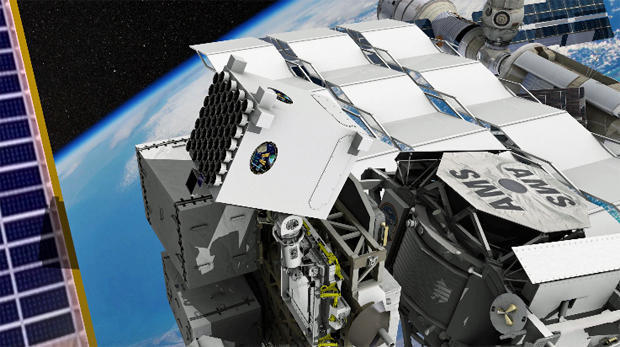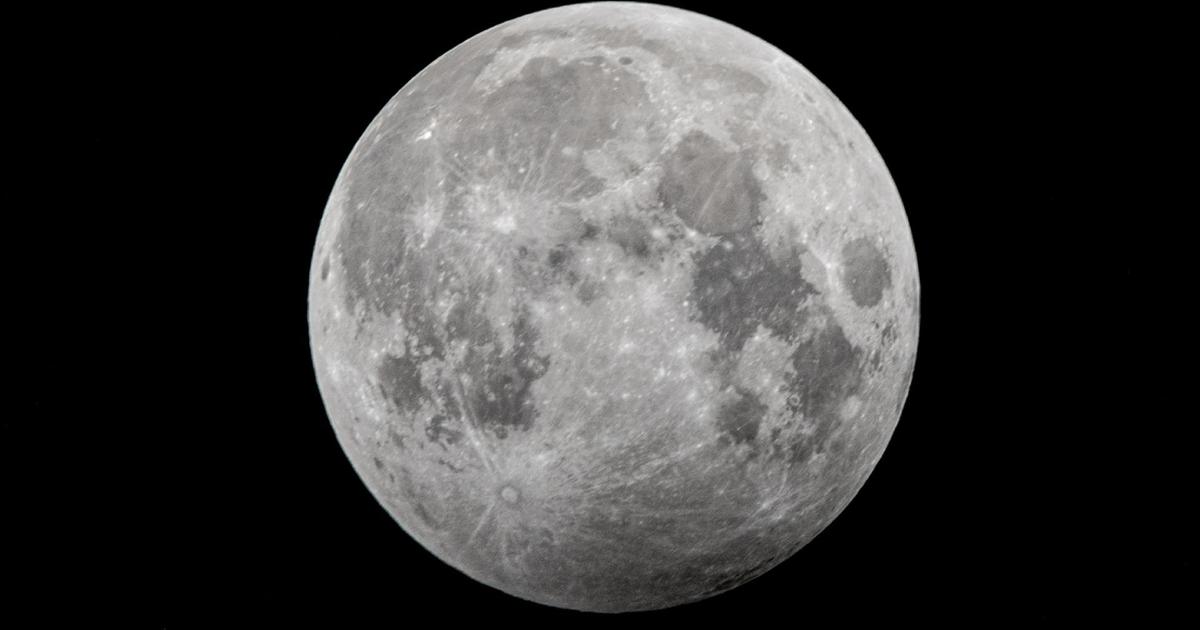Storms delay launch of "used" SpaceX cargo ship
Stormy afternoon weather and a nearby lightning strike grounded a SpaceX Falcon 9 rocket Thursday, forcing a two-day delay for launch of a space station-bound Dragon cargo ship loaded with 6,000 pounds of supplies and equipment.
The scrub was a disappointment to researchers awaiting the Dragon's arrival at the station to kick off a wide variety of experiments, including one to study fast-spinning neutron stars, or pulsars, to find out if they can be used as ultra-precise navigation beacons for future deep space missions.
"The fact that we have these pulsars apparently flashing away in the sky (hundreds of times per second) makes them interesting as tools," said Zaven Arzoumanian, science lead for Neutron star Interior Composition Explorer, or NICER, instrument mounted in the Dragon's unpressurized trunk section.
"You can imagine having a system of clocks, very accurate clocks, distributed all over the sky. ... So in the same way that we use atomic clocks on GPS satellites to navigate our cars on the surface of the Earth, we can use these clock signals from the sky, from pulsars, to navigate spacecraft anywhere in the solar system."
Launch Thursday from pad 39A at the Kennedy Space Center was targeted for 5:55 p.m. EDT (GMT-4), roughly the moment Earth's rotation carried the Falcon 9 rocket into the plane of the space station's orbit.
But clouds built up over the launch site late in the day and a lightning strike within 12 miles forced mission managers to order a scrub. Friday was not available for a second launch try due to the space station's orbit, so engineers recycled for another attempt Saturday at 5:07 p.m. Forecasters predicted more uncertain afternoon weather.
This will be the 100th launch from pad 39A which sent the Apollo 11 moonship on its way to the first lunar landing in 1969 and hosted the first and last space shuttle missions in 1981 and 2011 respectively. SpaceX now operates the launch complex under a 20-year lease with NASA.
As usual with flights to low-Earth orbit, the Falcon 9's first stage will have enough left-over propellant to attempt a return to the Cape Canaveral Air Force Station, touching down at Landing Zone 1 about eight minutes after liftoff.
SpaceX's record for first stage recoveries stands at 10 successes in 15 attempts, with six stages landing on off-shore droneships and four at the Air Force station. Recovering, refurbishing and re-launching booster stages is a key element in SpaceX founder Elon Musk's ongoing drive to dramatically lower launch costs.
In that same vein, the pressurized capsule section of the Dragon cargo ship being launched by the Falcon 9 is making its second flight to the station, the first time an orbital spacecraft has returned to space since the shuttle program ended in 2011. The cargo ship previously flew to the station in September 2014 in SpaceX's fourth resupply mission.
Of all the spacecraft that deliver cargo to the station -- the Russian Progress, Orbital ATK's Cygnus, Japan's HTV and SpaceX's Dragon -- only the Dragon is designed to return to Earth, bringing cargo and science samples back to engineers and researchers and preserving flight hardware for reuse.
Assuming an on-time launch Saturday, the Dragon will catch up with the space station early Monday, pulling up to within about 30 feet of the lab complex around 10 a.m. and then standing by while astronaut Jack Fischer, operating the lab's robot arm, lock onto a grapple fixture.
From there, flight controllers at the Johnson Space Center in Houston will take over, operating the arm by remote control to pull the capsule in for berthing at the Earth-facing port of the station's forward Harmony module.
The Dragon's pressurized cabin, accessible by the station crew, is packed with some 3,700 pounds of equipment and supplies, most of it devoted to research including one experiment that will use fruit flies to learn more about how heart cells are affected by prolonged exposure to weightlessness and another that will use 40 mice to study bone loss therapies.
"Men and women past the age of 50, on the average, lose about a half percent of bone mass per year," said Chia Soo, principal investigator for osteoporosis study. "But in microgravity conditions, the astronauts, on average, lose anywhere from 1 to 2 percent of bone mass per month. So that ... has tremendous implications for humans with respect to long-term space travel."
Soo said the mice will be treated with a chemical known as NELL-1 that shows promise for slowing bone loss and aiding regeneration.
"We are hoping this study will give us some insights on how NELL-1 can work under these extreme conditions," she said. "And if it can work for treating microgravity related bone loss, which is a very accelerated, severe form of bone loss, then perhaps it can (be used) for patients one day on Earth who have bone loss due to trauma or due to aging or disease."
Three payloads are mounted in the Dragon's unpressurized trunk section: a commercial mounting platform known as MUSES that can support multiple Earth-sensing payloads; an experimental, rolled-up solar panel known as ROSA that could lead to lighter, more powerful arrays; and the NICER neutron star telescope package.
NICER and MUSES will be extracted by the station's robot arm and mounted on the lab's power truss.
ROSA will be held by the robot arm and subjected to a series of engineering tests to determine its power generation capabilities, its structural rigidity and how it behaves when subjected to temperature extremes as the station moves into and out of sunlight.
"ROSA is important to the space industry," said principal investigator Jeremy Banik. "All spacecraft need power, and traditional solar panels are made with square, flat plates that accordion fold with mechanical hinges.
"The problem is, these panels tend to be heavy and bulky, and we just can't make them any bigger than what we do today. ROSA solves this problem by shrinking mass by 20 percent and stowed volume by a factor of four over these rigid panels."
The ROSA -- Roll-Out Solar Array -- launches stowed like a roll of paper towels. Once attached to the robot arm, the array will be unrolled to test the deployment technology and power generation. The panel measures 15 feet by 5.5 feet when fully extended.
Banik said engineers are looking at "scaling ROSA up to very high power levels, in the range of 30, 100 even 500 kilowatts for applications like solar electric propulsion. So we're pretty excited for ROSA."
The Neutron Star Interior Composition Explorer instrument will be mounted on the upper right side of the station's power truss. It will study X-rays from neutron stars to learn more about their inner workings.
"Neutron stars are fantastical stars that are extraordinary in many ways," Arzoumanian said. "They are the densest objects in the universe, they are the fastest spinning objects known, they are the most strongly magnetic objects known."
Neutron stars form when massive stars run out of nuclear fuel. When fusion in the core stops, there is nothing to counteract the inward pull of gravity and the core collapses as the outer layers of the star are explosively blown away.
The core's collapse stops due to quantum mechanical effects that counteract the inward pull of gravity, which crushes electrons into protons and leaves "a giant ball of neutrons" a few dozen miles across, Arzoumanian said. The mass of these city-size objects ranges from one to several times the mass of Earth's sun.
"We have very high density, very rapid rotation," Arzoumanian said. "The fastest known neutron stars -- pulsars -- spin at hundreds of times every second. They're spinning faster than the blades of a household blender."
Pulsars emit beams of radiation from their magnetic poles and as they spin, the beams can pass across the solar system depending on their orientation.
"They're giant flywheels. With the mass and the spinning speed that they have, there's nothing capable of disturbing their rapid rotation, and that makes them extremely stable," said Arzoumanian. "So if we can time the flashes, we have very accurate clocks. Over months and years, the accuracy of pulsars as clocks rivals or beats the atomic clocks we can make here on Earth."
The NICER instrument will measure those flashes with extreme precision, shedding light on the basic physics of neutron stars and helping engineers test technology that could one day lead to deep space navigation systems.
The NICER instrument is "significantly oversized for the navigation demonstration," Arzoumanian said. "NICER is very modular, we have 56 parallel telescopes packed into this box. Our simulations and calculations suggest the navigation needs of an interplanetary cruise mission could be met with just one or two of the 56 telescopes. So it could be made much more compact."
While pulsar-based navigation systems will not eliminate the need for Earth-based tracking, he said it would greatly reduce reliance on NASA's Deep Space Network.








